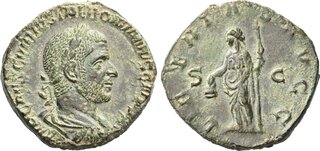| Numismatica Ars Classica > Auction 144 with CNG & NGSA | Auction date: 8 May 2024 |
| Lot number: 1150 Price realized: This lot is for sale in an upcoming auction - Bid on this lot  | Show similar lots on CoinArchives Find similar lots in upcoming auctions on |
| Lot description: The Geoffrey Cope Collection of Ancient Greek and Roman Bronzes. The Roman Empire. Trebonianus Gallus, 251 – 253. Description Sestertius, Roma 251-253, Æ 29 mm, 16.12 g. IMP CAES C VIBIVS TREBONIANVS GALLVS [AVG] Laureate, draped and cuirassed bust r. Rev. LIBERTAS AVGG / S – C Libertas standing l., holding pileus and sceptre. Reference C 64 var. (not cuirassed) RIC 114 Condition Lovely light green patina and extremely fine Ever since the murder of Commodus late in A.D. 192 the office of emperor had been the object of open competition among senior military commanders and the occasional politician. By the time Trebonianus Gallus was hailed emperor by his soldiers in the summer of 251, no fewer than 23 men and boys had issued coins bearing the title of Augustus since the death of Commodus. Gallus had come to power just after a terrifying ambush by Goths had wiped out an entire Roman army and had claimed the life of the reigning emperor, Trajan Decius. Gallus agreed to a humiliating truce with the Goths before marching to Rome to seek the senate's confirmation of his battlefield appointment. This, perhaps, was his great error in judgement for the Goths invaded the Balkans yet again and the Sasanian King Shapur I took advantage of Rome's weakness to capture Armenia. Meanwhile, the plague was spreading wildly, claiming even the life of Gallus' young co-emperor Hostilian. Shapur advanced further, sacking Antioch in 252/3, and the Goths and Germans raided Asia Minor, pillaging as far south as Ephesus. Amid so many crises, which Gallus seemed powerless to prevent, the vigorous actions of Aemilian, the governor of Lower Moesia, was an ember of hope. Aemilian executed Goths who remained in Roman lands and crossed the Danube to score further victories. Considering his success and Gallus' inaction, it is hardly surprising that Aemilian was hailed emperor by his troops and was compelled to march against Gallus, who in the spring or summer of 253 was murdered by his own soldiers not far from Rome. Aemilian's glory was short-lived, though. The reinforcements from the Rhine that Gallus had ordered finally arrived under the command of Rome's next emperor, Valerian. In a ferocious battle, Aemilian died, after which Valerian and his son Gallienus each assumed the title of Augustus Estimate: 500 CHF |  |



